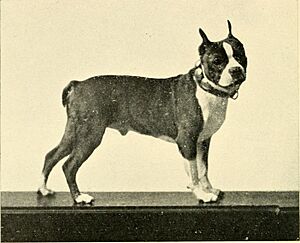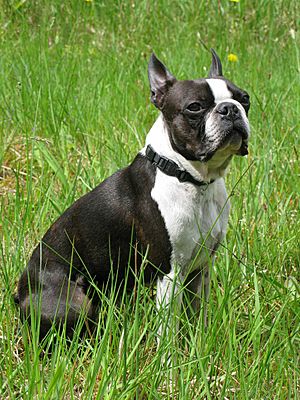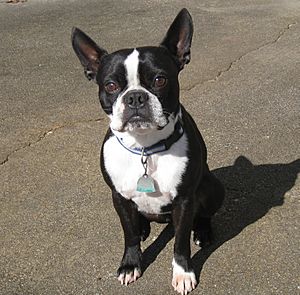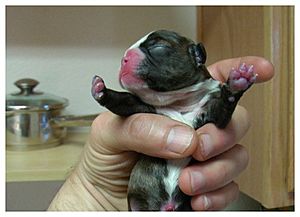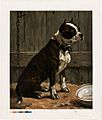Boston Terrier facts for kids
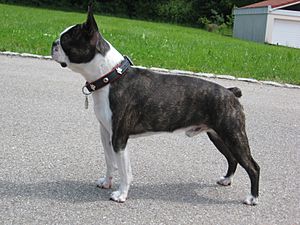
Boston Terrier with a black brindle coat
|
|||||||||||||||||||||||||||||
| Other names |
|
||||||||||||||||||||||||||||
|---|---|---|---|---|---|---|---|---|---|---|---|---|---|---|---|---|---|---|---|---|---|---|---|---|---|---|---|---|---|
| Origin | United States | ||||||||||||||||||||||||||||
|
|||||||||||||||||||||||||||||
|
|||||||||||||||||||||||||||||
| Notes | State dog of Massachusetts | ||||||||||||||||||||||||||||
| Domestic dog (Canis lupus familiaris) | |||||||||||||||||||||||||||||
The Boston Terrier is a special dog that first came from the United States of America. People often call them "American Gentlemen" because of their neat look. In 1893, the American Kennel Club officially recognized them as a non-sporting breed.
Boston Terriers are small and strong dogs. They have a short tail and ears that stand up straight. In 2022, the Boston Terrier was the 24th most popular dog breed registered with the American Kennel Club.
Contents
History of the Boston Terrier
The Boston Terrier breed started around 1870 in Boston. A man named Robert C. Hooper bought a dog named Judge. Judge was a mix of a bull and terrier type dog.
Many people believe that Hooper's Judge is the main ancestor of almost all modern Boston Terriers. Judge weighed about 32 pounds (15 kg). He was bred with a female dog named Gyp, who was a white bulldog-type dog. Gyp weighed about 20 pounds (9.1 kg) and had a strong, blocky head.
From these two dogs, breeders worked to make the Boston Terrier look like it does today. These dogs were originally bred from larger fighting dogs. The first Boston Terriers were much bigger, weighing up to 44 pounds (20 kg).
The Boston Terrier Club was created in 1891. In 1893, it became part of the American Kennel Club. This makes the Boston Terrier one of the few dog breeds that started in the United States.
At first, the color and markings of the dogs were not very important. But by the 1900s, their special markings and colors became a key part of the breed's look. Boston Terriers are now much less aggressive than their ancestors. They usually love being with people.
Since 1922, Boston University has used a Boston Terrier named Rhett the Boston Terrier as their mascot. Also, since 1979, the Boston Terrier has been the official state dog of Massachusetts.
What Boston Terriers Look Like
The Boston Terrier is a well-built dog with a strong, compact body. They have a square-shaped head with ears that stand up. Their neck is slightly curved.
Their muzzle is short and usually smooth, without many wrinkles. Their chest is wide, and their tail is short. Most Boston Terriers weigh no more than 25 pounds (11 kg). They usually stand about 15–17 inches (380–430 mm) tall at their shoulders.
The American Kennel Club divides Boston Terriers into three weight groups. These are under 15 pounds, 15 to under 20 pounds, and 20 to 25 pounds.
Coat and Color
Boston Terriers usually have white markings mixed with black, brindle, or seal colors. Seal looks like black but has a reddish tint in certain light. Solid colors or colors not mentioned are not allowed by the breed's official standards.
The American Kennel Club says Boston Terriers must have a white chest, a white band on their muzzle, and a white band between their eyes. It's also nice if they have a white collar and white on their legs. For dog shows, it's best if their markings are even on both sides.
Because their markings look like a tuxedo, and they have a polite personality, Boston Terriers are often called "the American Gentleman."
Special Features
One special thing about Boston Terriers is their large, round eyes. Their eyes are set wide apart and are quite big.
The breed's genes give them a naturally short tail. These tails can be curly like a corkscrew, or they can be straight. Boston Terriers' tails are usually no longer than 2 inches (51 mm).
Boston Terrier Personality
Boston Terriers are usually gentle dogs with a happy and friendly personality. They often have a fun sense of humor. They love to please their owners and are usually easy to train.
They can be very protective of their families. This might make some males act a bit territorial towards other pets or strangers.
Both male and female Boston Terriers are usually quiet. They only bark when they need to. Because they don't bark much, they are great pets for people who live in apartments. They enjoy being around people and usually get along well with children, older people, and other pets if they are taught how to socialize properly.
What Boston Terriers Eat
Just like you need vitamins and minerals, Boston Terriers need certain nutrients to stay healthy. These include:
- Protein: This helps build and repair their muscles. It's like the building blocks for their body.
- Fats: These give them energy and help keep their skin and coat healthy and shiny.
- Carbohydrates: These also give them energy for playing and running.
- Vitamins and Minerals: These help their body work properly and stay strong.
- Water: This is super important for keeping them hydrated and healthy every day.
The amount of food a Boston Terrier needs depends on a few things:
- Age: Puppies need more food than adult dogs because they are growing fast.
- Size: Bigger Boston Terriers might need more food than smaller ones.
- Activity Level: Dogs that run and play a lot need more food than dogs that mostly relax.
Generally, adult Boston Terriers need about 1 to 1.5 cups of dry dog food per day. This should be split into two meals. Puppies might need more. You should always check with your vet to be sure about the right amount of food.
Avoid giving your dog certain foods, as they can be harmful:
- Chocolate: This is very dangerous and poisonous to dogs!
- Grapes and raisins: These can cause serious kidney problems.
- Onions and garlic: These can damage their red blood cells.
- Salty or fatty foods: These can make them sick and cause other health issues.
Boston Terrier Health
A study in the UK in 2024 found that Boston Terriers live for about 11.8 years on average. This is a bit less than the average for all purebred dogs, which is 12.7 years.
Sometimes, Boston Terriers can have a curved back, called "roaching." This might be caused by problems with their back legs, which makes them lean forward.
Boston Terriers are a brachycephalic breed. This means they have a short muzzle and a "pushed-in" face. This can make it harder for them to breathe. Problems from this can include noisy breathing, snoring, and sometimes throwing up. They can also get skin infections in their face folds.
Because of their short snouts, they might have trouble cooling down when it's hot. They also need special care when they are under anesthesia for surgery.
Female Boston Terriers often need a caesarean section to give birth. Over 80% of litters in a UK survey were born this way.
Boston Terriers can also get certain skin conditions, like allergies or hair loss in patterns. They are also more likely to get hereditary cataracts, which are problems with their eyes.
A study in North America looked at veterinary records for many dogs. It found that only a small number of Boston Terriers (0.36%) had hip dysplasia, which is a problem with the hip joint. This is much lower than the average for all dogs (3.52%).
Famous Boston Terriers
In 1921, a brave war dog named Sergeant Stubby was given a gold medal by the U.S. Army. Sergeant Stubby was a Boston Bull Terrier. He earned a rank in the U.S. Army, becoming the first dog to ever do so. He was a comforting and protective dog during the war. France also gave him a medal. Sergeant Stubby passed away in 1926, remembered as the United States' "greatest war dog."
Wofford College in Spartanburg, SC has a live Boston Terrier mascot named Blitz. Blitz has been their mascot since 2003 and attends home football games.
In 2012, a high school student named Victoria Reed found out her Boston Terrier, Bruschi, had very large eyes. She sent a photo to Guinness World Records. Bruschi's eyes are 1.1 inches (28 mm) wide. Guinness recognized Bruschi as the dog with the largest eyes in the world.
Lennu was the pet of Sauli Niinistö, the President of Finland, from 2012 to 2021. Lennu was often seen with the President at less formal events and was well-known in Finland. Photos of the pair became very popular in the United States in 2017.
Related Pages
Images for kids
See also
 In Spanish: Boston terrier para niños
In Spanish: Boston terrier para niños
- Dogs portal
- List of dog breeds
- Bull-and-terrier
- Bull-type terriers



